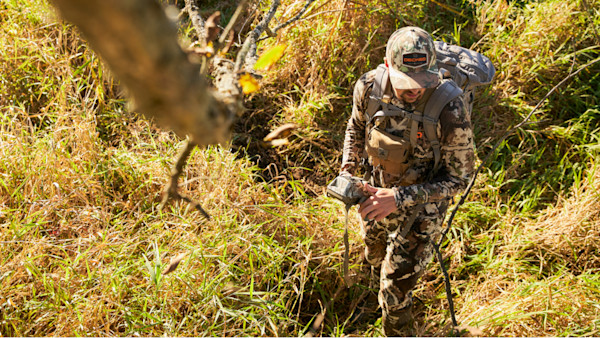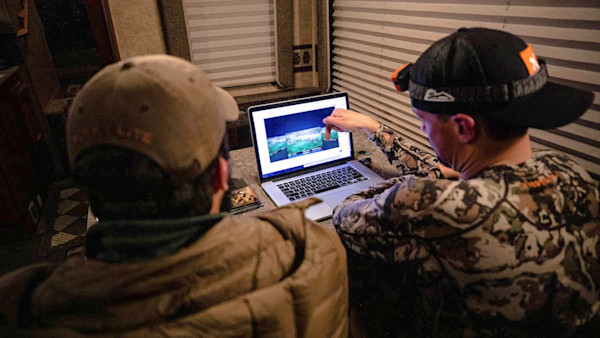
It's hot, the mosquitos and deer flies are out for blood, and velvet racks are packing on inches by the day. If you're a whitetail fanatic itching for fall, it's an exciting time of year. Of course, nothing replaces real-time, in-season intel, but gathering inventory on big bucks that may be around in a couple months should start now. We can learn a lot about what bucks are in the area and how their summer patterns transition into fall the better.
Low-Impact Scouting for Success When it comes to running trail cameras, we can be our own worst enemies. The anticipation before a card check is like a Lab waiting for his evening treat; it's almost unbearable. Your palms are sweaty, mind is racing, and with each passing image, your breath pauses slightly as another deer comes across the screen. You’re waiting for that mature, blocky body with head gear that will keep you awake at night.
Unfortunately, temptation gets the best of us too often. Giving in and checking cameras too frequently is a one-way ticket to over-pressuring your hunting area, a bad habit that’s almost guaranteed to do more harm than good. Ideal conditions for checking cameras are right before or even during a rain, although strong winds that mask movement and noise can be good too. These "freebie checks" as I like to call them come with a “reset” button after you've been on the property; the weather makes it as if you were never there. The goal is to affect movement and activity with your presence as little as possible. This helps gather as much information about natural movement and patterns as you can. The frequency of my pre-season summer card checks depends on the location of the camera.
The wildcard in this approach is the increasing popularity of cell phone cameras, which have changed the game in a big way. Getting pictures almost instantaneously without setting foot in your hunting area allows you to take inventory of what is using the property without adding pressure. But this technology isn't without hurdles. I battle cell reception in many of the areas I hunt, which can result in shoddy picture deliveries. This technology isn’t cheap, either. The costs seem to be dipping some, but you're going to need expensive batteries to keep them running and the monthly fees for the services can add up quickly if you aren't careful.
Chumming the Herd One of the most effective ways to take inventory is to lure deer in with supplemental feeding and attractants. Attractants appeal to the nose and stomach of deer. Proven attractants include corn, mineral licks, and other strong aroma supplements. I like to use different types of attractants depending on the location of a camera. Be sure to check your county and state game regulations to make sure attractants are permitted. Read carefully; these regulations can vary significantly from region to region. I recommend calling and talking with a game warden to have the rules clearly explained straight from the source. I also advise against doing this in areas that have CWD, although your state game agency has probably already accounted for this in their regulations.
I try to set up my cameras and attractants to coincide with natural behavior as much as possible. I accomplish this by breaking the property up into three sections. These cameras aren't in the exact locations I plan to hunt since so much will change over the months that follow, but the focus during this time of year is to see what’s in the area. Every property is unique, so it isn't an exact science, but the main goal is to have a strategy that you can tweak and adjust to your specific situation.
The sections I define start from the perimeter of the property and work inward. The outer sector is along a field edge, transition, or a large opening away from cover. This chunk should get checked most frequently, anywhere from once every couple of weeks to every 10 days. I typically use corn in the outer sector as my attractant because I can get to the site easily and most often.
Corn won’t last long if you're in an area with a moderate deer density. It's ideal to access a site in an outer sector with a bike, side by side, or even a truck to transport enough corn to last longer than just a few days. Most of the images I get there are at night, but since this section functions purely as a rollcall of the bucks using the property, the time of day doesn't matter.
The second spot I place a camera is in an area for transitional travel or staging. I like these camera sites to pair with habitat or terrain features that funnel movement in some way. Features like a flat or bench on a ridge, an opening off a creek crossing or an intersection of multiple trails are good places to start. I am still cautious about not getting these cameras too close to bedding areas or security cover to keep intrusion minimal during card checks and attractant replenishment. I like to check these sites no more than once a month.
Mineral blocks work great in these setups because they aren't something deer will rely on as food and they seem to be just enough to pause a buck, which will get a couple of pictures before he goes on with his natural agenda. I dive a little deeper into what the pictures are telling me in this sector. I note frequency, direction of travel, and how often the site is visited in daylight compared to dark. This time of year, the information isn't telling me much, but I want to start looking for clues relative to a buck’s home range.
The third and final section is where things get a little trickier. Patience is key here. I only push close to the core of a property if a bedding area is multiple acres in size in an attempt to learn a little more about how deer are using the bedding area. I also try to find some more habitat or terrain features that focus natural travel. Even though I'm pushing further in, I don't want to set the site up on the edge or in thick cover. Instead, I focus on travel leading to and coming from bedding.
I haul in two to three mineral blocks depending on the size and some corn to help the site get established a little faster. The multiple blocks usually keep the site active for at least a couple months. I will only check these sites one time throughout the summer before going back in to pull the camera just after bucks shed their velvet. Since the location is closer to a core area, it's essential not to make multiple trips in to pull cards. The last thing you want to do is push a buck if there's a good chance you've found his core area. The chess match is set for the fall.







Conversation